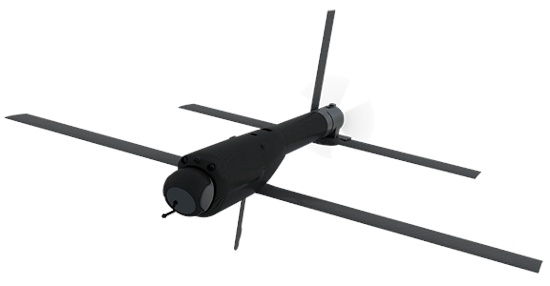AeroVironment Switchblade
The Switchblade UAV / loitering munition has its origin in an Army Research Lab project named SOAR (Silent Operating Aerial Reconnaissance), which was started around 2003. It called for a backpackable tube-launched expendable mini-UAV for over-the-horizon ISR (Intelligence, Surveillance and Reconnaissance) missions, while operating with a very low acoustic signature. For this requirement, AeroVironment developed the initial Switchblade UAV, which features two sets of wings in tandem, twin vertical stabilizers, and a propeller driven by an electric motor. All flying surfaces and the propeller are folded flush with the fuselage while in the storage/launch tube. A pneumatic system is used to eject Switchblade from the tube, and the propeller, wings and tail are extended immediately after launch (hence the name of the UAV).
 |
| Photo: AeroVironment Inc. |
| Switchblade (early SOAR model) |
In the mid-2000's, DARPA and the AFRL (Air Force Research Lab) researched so-called loitering muntions, essentially small UAVs armed with a lethal warhead, which loiter the battlefield for some time to wait for a target of opportunity. The Switchblade was possibly one of the specific designs involved in this research. In any case, from around 2010 Switchblade was definitely being developed as an offensive weapon, under the Army label LMAMS (Lethal Miniature Aerial Missile System). In July 2011, the Army awarded AeroVironment a contract for "rapid fielding" of Switchblade in Afghanistan, and in 2012, the U.S. Marine Corps also started ordering the system for its troops. By that time, the layout of the airframe had notably changed. Engine and propeller were moved to the tail, and the aft set of wings had reduced span.
 |
| Photo: AeroVironment Inc. |
| Switchblade 300 Block 20 |
The Switchblade was re-labeled as Switchblade 300, when the larger Switchblade 600 was introduced in 2020. The latest model, Switchblade 300 Block 20, has a loitering endurance of around 20 minutes. Using the vehicle's EO/IR camera system, the operator can search for targets, and when one is found, designate it and have the Switchblade dive on it to deliver its explosive payload. The 1.8 kg (4 lb) warhead is effective against personnel and lightly armoured vehicles. It directs its blast and fragmentation pellets primarily in the flight direction of the missile, to maximize the effect on the target and minimize collateral damage. An attack can be cancelled until a few seconds before impact. If no target is found until the battery is running out, the vehicle can be destroyed in flight (unlike a UAV, the Switchblade is non-recoverable).
The Switchblade 600 variant uses the same priciples as the 300, but is significantly larger and has an anti-armor warhead for effective use against armored vehicles. In 2023, the U.S. Army announced, that it wouldn't buy additional Switchblade 300 rounds, but instead ordered more than 100 Switchblade 600 as part of its LASSO ( Low Altitude Stalking and Strike Ordnance) program.
 |
| Photo: AeroVironment Inc. |
| Switchblade 600 |
Since 2022, Switchblade has gained some notoriety for its use in the Russia/Ukraine war. Loitering munitions like Switchblade, as well as make-shift devices created by fitting commercial off-the-shelf drones with explosives, have been referred to as "kamikaze drones". Many hundreds of Switchblade 300 rounds from U.S. military stocks have been provided to Ukrainian forces, which used them with somewhat mixed results.
Specifications
Note: Data given by several sources show slight variations. Figures given below may therefore be inaccurate!
Data for Switchblade 300, Switchblade 600:
| Switchblade 300 | Switchblade 600 | |
|---|---|---|
| Length | ? | ? |
| Wingspan | ? | ? |
| Weight | 3.6 kg (8 lb) | 29.5 kg (65 lb) |
| Speed | max: 160 km/h (100 mph) loiter: 100 km/h (63 mph) |
max: 185 km/h (115 mph) loiter: 113 km/h (70 mph) |
| Ceiling | > 4500 m (15000 ft) | |
| Range | 20 km (12.5 miles) | 40 km (25 miles) |
| Endurance | 20 min | 40 min |
| Warhead | 1.8 kg (4 lb) high-explosive | 15 kg (33 lb) anti-armor |
| Propulsion | Electric motor | |
Main Sources
[1] Aviation Week & Space Technology "Aerospace SourceBook 2006"
[2] NDIA Proceedings: Mortar-Launched Recon/Targeting Programs
[3] AeroVironment Inc. Website
[4] Wikipedia: AeroVironment Switchblade
[5] Defense Update: Switchblade – Miniature Loitering Weapon
[6] "1945", David Hambling:
The U.S. Army Won’t
Buy Any More Switchblade 300 Kamikaze Drones
Back to Directory of U.S. Military Rockets and Missiles, Appendix 4
Last Updated: 22 January 2024